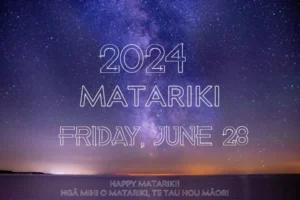The History and Significance of Matariki in New Zealand Culture
Matariki is a significant celebration in the Māori culture and has been gaining recognition and importance in New Zealand’s wider society. It is the Māori name for the Pleiades, a cluster of seven stars that is visible in the southern hemisphere during the winter months. Matariki marks the start of the Māori New Year and is a time of reflection, celebration, and renewal.
History of Matariki
Matariki has been celebrated by the Māori people for hundreds of years, with its origins dating back to pre-European times. The exact year of the first Matariki celebration is not known, but it is believed to have been celebrated for centuries, possibly even millennia.
Traditionally, Matariki was a time to give thanks for the bounty of the land and sea and to acknowledge the role of the stars in guiding the planting and harvesting of crops. The Māori people would gather together to celebrate with feasting, singing, and dancing.
In the 19th century, the Māori New Year fell out of favor due to the influence of European culture and the suppression of Māori traditions. However, in recent decades there has been a resurgence of interest in Matariki and a renewed celebration of Māori culture in New Zealand.
Significance of Matariki
Matariki has deep cultural and spiritual significance for the Māori people. It is seen as a time to reflect on the past year, honor ancestors, and set intentions for the year ahead. The celebration of Matariki is an opportunity to strengthen the connection to the land, sea, and sky and to renew relationships with others.
The seven stars of Matariki each have their own significance and meaning:
- Matariki – the mother star, represents reflection and remembrance
- Pōhutukawa – represents those who have passed on
- Waitī – represents freshwater resources and the sustenance they provide
- Waitā – represents the ocean and the sustenance it provides
- Tupu-ā-nuku – represents food that grows beneath the ground
- Tupu-ā-rangi – represents food that grows above the ground
- Ururangi – represents the wind and the navigational abilities of the Māori people.
Celebrating Matariki
Matariki is celebrated in various ways throughout New Zealand. It is a time of community and family gatherings, feasting, and sharing of cultural traditions. Here are some ways to celebrate Matariki:
- Attend a Matariki festival or event: Many communities throughout New Zealand hold festivals and events to celebrate Matariki. These events often include kapa haka performances, traditional Māori food, crafts, and storytelling.
- Host a Matariki feast: Gather family and friends together to share in a feast of traditional Māori foods, such as kumara, puha, and rewana bread. This is a time to share stories, reflect on the past year, and set intentions for the year ahead.
- Learn about Māori culture: Use Matariki as an opportunity to learn more about Māori culture and traditions. This can include learning about the significance of the seven stars of Matariki, participating in traditional crafts, or attending a Māori language class.
- Connect with the land and sea: Matariki is a time to acknowledge the role of the land and sea in sustaining life. Take a walk in nature, go fishing or foraging, or plant a garden to connect with the environment and honor the bounty it provides.
- Create Matariki crafts: Matariki is a time to get creative and make crafts that honor the seven stars. This can include
Matariki Celebrations in Modern Times
Matariki’s resurgence in modern times can be attributed to the efforts of Māori leaders, educators, and communities who recognized the importance of keeping the tradition alive. In recent years, there has been a renewed interest in Matariki celebrations, with many events and activities organized throughout the country.
Matariki Festival in Auckland
One notable example is the annual Matariki Festival in Auckland, which features a wide range of events, including music and dance performances, art exhibitions, workshops, and storytelling sessions. The festival attracts thousands of visitors every year and has become an important platform for showcasing Māori culture and traditions.
Matariki Whānau Festival in Wellington
Other regions in New Zealand also have their own Matariki celebrations, such as the Matariki Whānau Festival in Wellington and the Matariki Festival in Christchurch. These events provide opportunities for people to learn about Māori culture and traditions and to connect with their community.
In addition to public events, Matariki is also celebrated in schools, workplaces, and homes throughout New Zealand. Teachers incorporate Matariki into their curriculum, and workplaces organize Matariki-themed events and activities to acknowledge and honor the Māori New Year.
Matariki has also become an important time for reflection and renewal, with people taking the opportunity to set new goals and aspirations for the year ahead. The seven stars of Matariki are often used as a guiding framework for these goals, with each star representing a different area of focus, such as health, education, and community.
History and Significance of Matariki
Matariki is an important cultural tradition in New Zealand that has been celebrated by the Māori people for generations. Its significance extends beyond the Māori community, with many New Zealanders now recognizing the importance of acknowledging and honoring Matariki. Through events and celebrations, people are able to learn about Māori culture and traditions, and to connect with their community. Matariki also provides a time for reflection and renewal, as people set new goals and aspirations for the year ahead. As Matariki continues to gain prominence in New Zealand, it is important to ensure that its traditions and significance are preserved and passed down to future generations.


